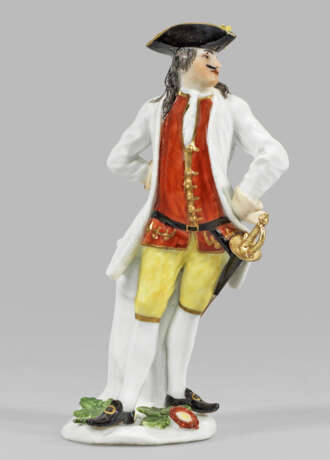ID 803211
Lot 2751 | "Capitano Spavento" aus der Italienischen Komödie
Estimate value
€ 22 000 – 44 000
für Johann Adolph II., Herzog von Sachsen-Weißenfels
Auf einem mit plastischen Blüten und Blättern belegten Sockel, in stolzer Haltung stehender und nach links blickender Komödiant in weißer Jacke über rotem Wams mit goldener Knopfleiste und weißem Hemd. Zur goldgesäumten Kniebundhose und weißen Strümpfen trägt er schwarze Schuhe mit Goldschnalle. Das dunkle, herabfallende Haar ist bedeckt von einem schwarzen Dreizack mit Schleifenbesatz. Seitlich ein um die Hüfte gegürteter Degen. Polychrome Malerei mit Goldstaffage. Entw. Johann Joachim Kaendler und Peter Reinicke, um 1744. Minim. rest.; Schwertermarke. Meissen. Um 1745. H. 14 cm.
Die von Johann Adolph II., Herzog von Weißenfels, einem Cousin August III., in Auftrag gegebene Figurenserie umfasst etwa 15 Figuren. Die zwischen 1743 und 1745 entstandenen Figuren sind von Peter Reinicke unter der Leitung des Modellmeisters J. J. Kaendler und größtenteils nach Stichvorlagen von François Joullain für Luigi Riccobonis "Histoire du Théatre Italien" (Paris 1728) gefertigt worden. Die Commedia dell'arte bezeichnet eine Form des Stegreif- bzw. Improvisationstheaters und entstand im Italien des 16. Jhs. Hierbei erfolgt die Inszenierung nach einem losen Handlungsszenario (sog. canovaccio) ohne geschriebenen Text, wobei die Schauspieler festgelegten, stereotypischen Figuren/Charakteren folgen und auf der Bühne improvisierend agieren. Es lassen sich zwei Hauptgruppen unterscheiden: die Vecchi (Gruppe der reichen Oberschicht) und die Zanni (das einfache Volk, Diener). Variabel eingesetzt, erscheint auch die Gruppe der Innamorati (Die Liebenden). Die Theatergruppen der Commedia dell‘arte im 18. Jh. traten erfolgreich an europäischen Höfen auf. Die Schauspieler verkörperten auf komödiantische Weise menschliche Tugenden genauso wie Schwächen, von denen sich die Zuschauerschaft entweder angesprochen fühlen konnte oder den sogenannten Spiegel vorgehalten bekam. Der "Capitano" (bzw. Capitano Spavento), erwähnt in Reinickes Arbeitsbericht vom August 1744 und gestaltet nach Joullains Stich "Habit de Capitan Italien", repräsentiert als Edelmann aus Mantua den Typus des hochmütigen und großspurigen Aufschneiders, der zuweilen Eigenschaften der Boshaftigkeit, Gier sowie der Feigheit aufweist.
Vgl. Jansen, Kat. Commedia dell'arte, Gesellschaft der Keramikfreunde, Nr. 36 sowie Beiband I, Nr. 25, Kunze-Köllensperger, Slg. Burda, Nr. 97.
A porcelain figure of Capitano from the Commedia dell'arte for Johann Adolf II, duke of Sachsen-Weißenfels. Modelled by P. Reinicke and J.J. Kaendler. Minor restored.
Meissen. Um 1745.
| Address of auction |
Kunstauktionshaus Schloss Ahlden GmbH Große Str. 1 29691 Ahlden(Aller) Germany | ||||||||||||||
|---|---|---|---|---|---|---|---|---|---|---|---|---|---|---|---|
| Preview |
| ||||||||||||||
| Phone | +49 5164 80100 | ||||||||||||||
| Buyer Premium | 25.0 | ||||||||||||||
| Conditions of purchase | Conditions of purchase | ||||||||||||||
| Business hours | Business hours
|



